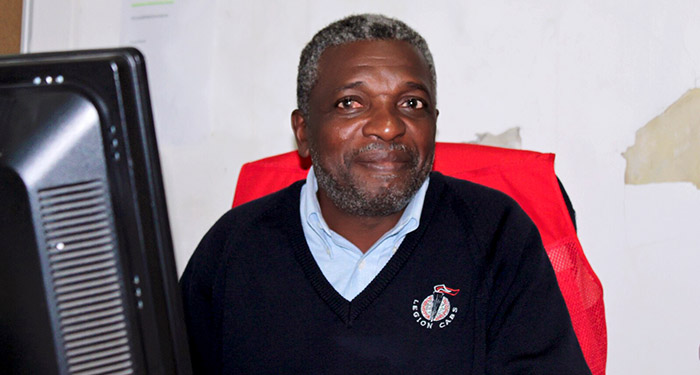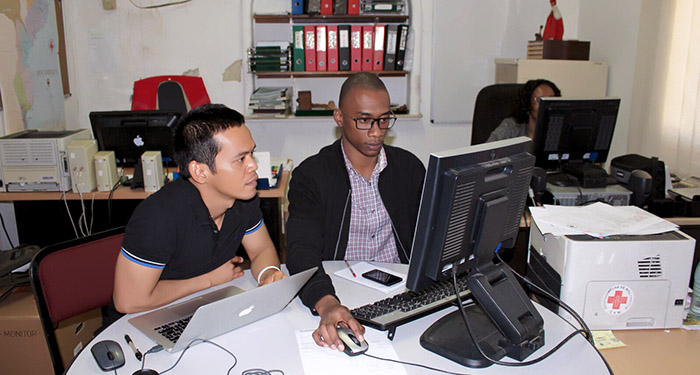 |
 |
 |
 |
notes from the field
This is a personal blog and does not reflect the views of the Red Cross Red Crescent Climate Centre
Juhri Selamet
Maputo, Mozambique
June - August, 2018
Learning and Maintaining Communication Channels of Mozambique Red Cross
July 30, 2018
View photo gallery for more photos in the field by Juhri Selamet
Having a large network with 70,000 subscribers, 5,500 active volunteers, and 220 employees, Cruz Vermelha de Moçambique (CVM) (Mozambique Red Cross) has multiple internal and external audiences. It has a nationwide network managed at the national level, provincial level, district level, administrative level, and locality level. Also, as a component of the Red Cross and Red Crescent (RCRC) Movement, Mozambique Red Cross has regular contact with the International Committee of the Red Cross (ICRC) and Climate Centre and works closely with both the German Red Cross, Spanish Red Cross and the Belgian Red Cross. Similarly, the Mozambique Red Cross has been working with diverse communities from governmental institutions, non-governmental organizations, international governmental organizations, civil societies, the general public, and the media.
Therefore, effective and efficient communication channels are imperative in making the internal and external audience understand the Mozambique Red Cross identity, functions, values, and principles. For this purpose, it is necessary to raise awareness among members, donors, volunteers and staff to build their capacity to make them follow the Seven Fundamental Principles of the Red Cross and Red Crescent Movement as well as the six principles of Mozambique Red Cross and values. Through this understanding, CVM will also be able to advocate for those vulnerable during humanitarian crises.
Based on the above perception, I have been learning about the CVM communication channels and how the information flows within the organization, to other organizations, and communities. I talked with Jose Tomas Felix, a Communication and Marketing staff member at the CVM. We discussed a wide range of communication channels including community meetings, posters, radio, SMS, and social media. "I like radio as a communication channel; it could reach rural areas," he said. "Social media is good for urban audiences." It is true that radio can reach large numbers of people from different segments of the community in Mozambique as opposed to social media. However, the airtime can be expensive. For this reason, the CVM currently only uses a radio spot once a year.

Photo: Jose Tomas Felix, Communication and Marketing staff member at the CVM. (credit:
Juhri Selamet).
As the discussion went on, I learned the importance of community meetings in the Mozambican context from Tomas. According to him, community meetings are a great way of sharing programme information and discussing things face to face, and local people usually prefer this form of communication. He said, "last time [in June 2018], our community meeting discussion was about the Measles Rubella Vaccination campaign to improve health and well-being in Mozambique." Before that, CVM also held a community meeting to share information of Phase III – “MERCADOS” project. These CVM community meetings were meant to support local community discussions and to gain feedback from the audiences.
According to Tomas, in order to get the public informed about CVM activities, programs, and events, CVM also publishes a bulletin called CVM EM NOTÍCIAS quarterly. He said, "I create a digital bulletin and send it to CVM provincial and district levels by email. They usually print that bulletin and distribute [it] to the community." This 8-page bulletin is designed in a manual printable format that contains rich information from disaster management services to training activities that have been conducted by CVM.
In this discussion with Tomas, I also addressed my desire to help CVM develop their presence on social media. As a communication channel, social media is an effective, instantaneous avenue for two-way communication, which can be critical before, during, and after a disaster or crisis as well as in non-crisis situations. Platforms such as Facebook and Twitter can be used to share early warning messages to communities in disaster-prone areas. These platforms can also be used to share practical information on where aid can be accessed after a disaster or crisis strikes. In non-emergencies, they can receive requests, comments, and feedback; encourage community action; and understand people’s perceptions of health and social issues. In this view, to me, social media could potentially work best for information as an aid for Mozambique in the future. However, for now, social media can exclude rural residents in Mozambique due to lack of internet access and the majority of the residents are not owning a smartphone. Therefore, to reach rural communities, CVM collaborates with Instituto Nacional de Gestão de Calamidades (INGC) (National Disasters Management Institute) working on DataWinners platforms. DataWinners is a two-way warning system in Mozambique to use cell phones for community members who have access to cell phones by adding a data collection component – community networks share pre-disaster warning messages and collect real-time post-disaster data. It also allows Mozambique’s National Disasters Management Institute and CVM to allocate resources and coordinate public services quickly.
To our social media conversation; "CVM currently is on Facebook. I try to post an update every day," Tomas said, showing me the Facebook page, which currently has 60 followers. "Do you have a twitter account for CVM?" I asked. He said no, but "it would be nice if we did have it." Thus, I promised Tomas to set up a Twitter account for CVM and migrate the content from Facebook to Twitter. I would like to take advantage of the Red Cross's big Twitter network and put the Mozambique Red Cross in this circle. Now on Twitter, for example, the German Red Cross has 101k followers, the Uganda Red Cross has 6k followers, the Indonesian Red Cross has 1.03M followers, the Croix-Rouge française has 349k followers, and the Cruz Roja Española has 110k followers.
After a long discussion with Tomas, he introduced me to Edson Rodriquez who will work to develop CVM communication channels. "I will be transferring to the Red Cross office in Cabo Delgado Province," Tomas said. He pointed out that CVM has a new website that is still under development. Moreover, I learned from Edson what he would like to begin to start generating content for CVM's website and creating a volunteer database. One of my offers is related to my software skills in creating and designing communication content. "I would like to learn Adobe skill sets," he said. In our first meeting, I started to explain the standard operation on how to work on InDesign, Illustrator, and Photoshop. Then, I began to teach him InDesign to support CVM to create both print and digital communication materials. I introduced to Edson InDesign craft layouts step by step and demonstrated all InDesign component tools.

Photo: Juhri Selamet (left) and Edson Rodriquez (right). (credit:
Juhri Selamet).
Edson is a quick learner. It did not take much time to teach him to learn how to operate and design in Adobe platforms. As a starter, he designed a poster for volunteer recruitment and then together we created a bulletin template that could easily be distributed by email. Through our meetings, we wanted to create as much content as we could to deliver through CVM communication channels. Therefore, we dived into the online communications platforms, where we worked on the website.
We went through each section of the website. We discussed the opportunity for the integration between online volunteer databases and social media channels. For volunteer databases, we considered some of the online database systems. After reviewing the advantages and disadvantages, we ended up using one of the database systems that we knew could work with no costs and was easy to operate both online and offline.
In addition, as I promised to Tomas, we have created a CVM Twitter account that is incorporated with the CVM Facebook account. We understand that social media requires people to have internet access to use it, but Twitter and Facebook, for instance, are inexpensive (almost no costs) and easy to manage with major potential to create sustainable communication channels from now to the future of CVM. Thus, we think taking advantage of these platforms can start now and eventually grow. We hope, in the future, these communication channels that we have created can be one of mechanisms in place for obtaining feedback from all stakeholders and the general public by listening to the online community in social media sphere and the issues that are important and what they say about the National Society and Red Cross Red Crescent Movement. Likewise, we hope it might help to foster CVM's relationships with donors, with Red Cross online communities, governments, as well as the general public in terms of sharing and informing the CVM humanitarian works.
After spending about 10 weeks taking notes, observing, and having many discussions to understand what works and what does not work in term of communication channels, from this learning process, I am starting to unpack the communication plan of CVM that I have developed as a recommendation to support the CVM strategic plan 2018-2021. As for the finalization, I will have a discussion again to learn the opportunity to set up the plan to put into a real action.

